Merrick White
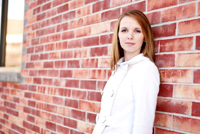
Tell us a little bit about your background: where you’re from and how that has made you what you are today.
I was born in Wisconsin, but I moved when I was four and grew up in Las Vegas my whole life. I think probably the biggest thing that influenced who I am and where I am today is my schooling. I was homeschooled from the time I started school all the way until high school. It created an environment for me and my siblings that allowed us to spend a lot of one-on-one time with my mom, so she was able to get to know us on a level that most moms don’t, I think. And that helped her tune in to our abilities and our talents early on. She was the one who pushed me into my art more than anyone. As a result of that, I pursued my artistic talents and went to BYU. I started out as an art major and graduated as an art major. Never once wanted to do anything else.
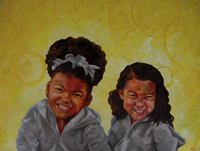
Did you have any formal training then?
I took a couple of art classes when I was younger, but I never really got into it then. My junior year of high school, my mom said, “Okay, I’m forcing you to take an art class—you have too much ability to just throw this away. Just take it, and if you hate it, you don’t have to do it. But at least take one class.” So I did, and within two weeks I turned in my first assignment and my teacher said, “You’re too good to be in this Art 1 class, so we’re moving you up to the next level.” My teacher was very good at getting us involved in contests and shows, and winning awards was this big thing for me. I realized that I did have some talent, and that got me into it.
When I applied for BYU, I started talking to my mom about what I wanted to major in. The obvious thing was art. So, I immediately started taking art classes there—drawing classes, mostly, until last August when I decided to take a shot at painting. I had a great teacher who was really good at explaining everything and starting out with the basics and helping us understand. I just fell in love with it and was inspired by her and her paintings.
Do you have a name for your particular style?
If people ask what I paint, I usually say oil portraiture because I paint a lot of faces. I wouldn’t say there’s a particular name for the style that I do. Since I just graduated from college, I’m still in that exploratory phase of my life where I like a lot of different things and haven’t decided on one particular thing. I think I’ll always do faces, but I’m still working on expanding my artistic repertoire.
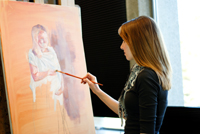
What’s a typical day like for you?
It’s pretty straightforward every day, since I have a full-time job. I get up, I go to the gym, I go to work, I come home from work. My husband usually gets home from work about an hour and a half after I do, so I have that time to make dinner and work on some of my art while it cooks. He leaves earlier than I do for work and gets home later than I do, and we only have these few hours together, so we usually spend most of our time together then. Sometimes I say okay, tonight is a painting night and I just have to work, and he’ll sit next to me while I work. It’s a real challenge to juggle all these different things: spending time with him and cleaning the house and doing the laundry and then getting my painting in. When I did my last show, after he went to bed I would paint until three in the morning every night because that was the only time I could paint.
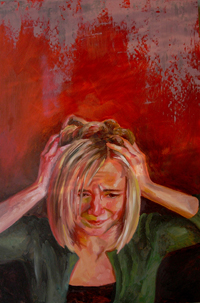
Tell us about your work process, taking a painting from start to finish. Does it change a lot from the beginning to the end?
Yes. It changes a lot. I constantly carry around a little sketch book with me and whenever ideas or compositions come to me, I write them down or sketch them out so I can remember them and come back to them. Then I take photos; I rarely use models just because it’s hard to afford them at this point, and trying to bribe a family member to sit there for hours on end is difficult as well.
After I take photos, I usually find three or four I like that I can work from. I’ve started making my own panels, since I don’t really like to work on canvas very much—I like working on a Masonite board or some other kind of board. So I prime that and color it and then I spend about an hour just sketching it out and finding that composition on the panel itself.
Then, after everything is measured and all accurate—it’s just a really loose sketch with charcoal—I tackle the painting with a big brush. I usually cover the entire surface of the painting and try to get everything with paint on it. I don’t do detail; I just try to get shapes right, and that usually takes me a couple days. After that, I go back and I repaint the entire thing with more detail, and that takes me another couple days.
It’s a tough process, but I learn something new every time, and the process does evolve a lot. Sometimes I end up changing the entire thing halfway through or covering it all with paint and starting completely over. Sometimes I love it right from the start, and sometimes I hate it and have to rework it over and over and over until I’m happy with it.
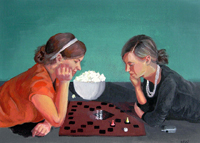
What are your favorite and least favorite parts of life as an artist?
I really love starting a new painting. I love thinking of ideas. Just the thought of making my paintings a reality gets me so excited. I also love working on my paintings and seeing the works in progress and what I’ve accomplished and seeing how my abilities increased with this particular painting. I love seeing my art up on people’s walls or in a gallery. That motivates me and it makes me feel like I’m accomplishing something and I’m doing what I want to do.
I think my least favorite part is the mess. I do all my painting right in my living room—it’s carpeted and I can’t even tell you how many times I’ve scrubbed paint out of my carpet. I think when it comes time to sell our condo I might be investing in a few well-placed rugs, because of all those darn spots! We’re planning on moving in the next couple months and when we do, I’m dedicating an entire room to my art that can get as messy as I want. Then it won’t be a problem.
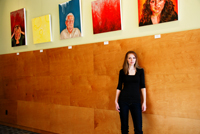
With your paintings, who do you see as your audience?
I feel like there’s still a lot of growth to be had in my artistic career, and I think that my audience will grow as my paintings grow. I think right now my audience is pretty much anyone who likes to look at art. I’ll gain a more specific audience when I find a direction that I’ll go in for a long time. Right now, when I’m doing a little bit of this and a little bit of that, pretty much everyone is my audience.
Tell us about working on your “Sadness I” painting.
When I decided on the idea of this show—to mix abstract ideas with people and their facial expressions—one of the first ideas I thought of was sadness. I thought that painted drips created a beautiful tears metaphor, so this particular imagery was on my mind through all the other paintings. The two sadness paintings were the last ones that I did. With every painting I did, I constantly thought of ideas for this one. I went through several different background colors and finally decided on blue. Blue tends to be a strong color, especially the blues that I paint with, and so I mixed a lot of different colors to create this blue and feel I got exactly the color that I wanted. It’s a beautiful blue, and it’s one of my favorite colors—kind of grayish-blue, like an overcast sky. I think it creates that solemn tone, and the white tears dripping down intensify that mood. With the painting with the man, I wanted to create his facial expression not like he was crying, but just that he was solemn and sad.
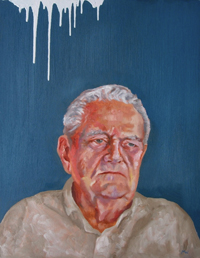
Do you have any ideas as far as what the theme of your next show will be?
I think I’m going to try to tackle just abstract paintings. My husband really loves abstract paintings and I’ve tried my hand at it a couple times. I’m going to work with geometric and organic shapes mixed together and how they contrast and clash, but I’m going to integrate them together.
Where do you see yourself in the future and what are your future ambitions and plans?
Well, right now I’m working full-time, but it’s not a full-time career that I’ll do for the rest of my life. I’m really dedicated to my art and I want to be a mom. I think that in the future I see a lot of late nights, because that’s really the best time for me to paint. I don’t want to let my life get too busy to give up on my art. I want to be a mom and I want to take care of my kids, but I always want to be sketching and thinking of ideas even if I’m not putting up shows and working on big projects; I always want to be an artist. My husband and I plan to create a business out of this and do commissions and shows and enter my art into a lot of things.
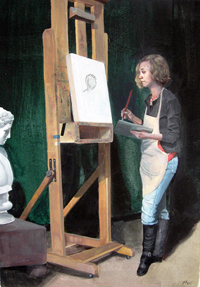
How does the gospel influence you in your art and as an artist?
I think that as an artist, especially an LDS artist, you paint what you feel and what you believe, whether it’s consciously evident in your art or if it’s just subconsciously what you paint. For my art, the gospel plays a huge role, but I think it’s less obvious than art like Simon Dewey or Liz Lemon Swindle, who paint gospel subjects. I don’t paint gospel subjects, and at this point I don’t plan to in the near future. But I love painting the human body, which is one of God’s greatest creations. I also love painting children. I think that painting these subjects is glorifying God, as long as they’re painted in a positive and a modest way.
How do you see your paintings fitting into the larger scheme of things?
I think I can at least show people that it’s possible to be both an artist and a mom, and that you don’t have to paint only LDS subjects to be an LDS painter. Take people like Minerva Teichert—regardless of what else went on in her life, she dedicated her life to art and she never let her passion die. I saw a couple of her shows when I was at BYU and found out that most of the time she left her easel in the kitchen so that she could be both a mom and an artist at the same time. That’s motivating to me.

I feel like I can build the kingdom in a positive way through my art just by being an example of good and wholesome art, and by being an artist in the LDS community and in other communities. As for having a family and still being an artist, I’ll have to take that as it comes because I’m not at that stage yet, but I’m never going to let that passion die. I want it to be integrated into my family as a part of my family’s culture—that I am an artist. Regardless of what we paint, as long as it’s good and wholesome, we can build the kingdom in our own little way.
What’s the most satisfying part of painting?
Probably when someone comes up to me or e-mails me and says, “I loved that particular piece! That meant so much to me.” Getting the feedback from people. I mean, I hear it from my husband and I hear it from my mom, but they always say it’s good. When a total stranger is moved and inspired by my art, I feel completely satisfied—I feel that I’m doing what I want to do and that I’m accomplishing my dream. ❧
